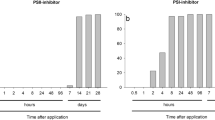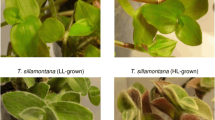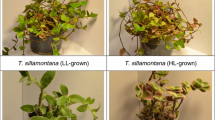Abstract
Photosystem II-herbicides (bentazone*, diuron) not only block photosynthetic electron transport, but have additional effects on the cell metabolism of Raphanus seedlings. They induce the formation of shade-type chloroplasts with a different ultrastructure and prenyllipid composition. This is shown by higher grana stacks as well as by higher chlorophyll b and lutein amounts with reference to chlorophyll a, and lower levels of the plastidic prenylquinones (plastoquinone, phylloquinone, α-tocoquinone) and β-carotene as compared to the controls.
The two herbicides bentazone and diuron change the labelling pattern of the chloroplast pigments from 3H-mevalonic acid and 2-14C-acetate and also reduce the accumulation of anthocyanin (pelargonidin), which is a further indication of a shade-type growth response. The level of ubiquinone, an indicator for mitochondrial activity, is, however, increased.
Similar content being viewed by others
References
Abel, B (1956) Ober die Beerinflussung der Chloroplastenstruktur durch Licht bei Antirrhinum majus (haploid). Naturwissenschaften 43: 136–137.
Ashton, FM and Crafts, AS (1973) Mode of action of herbicides. New York: J. Wiley.
Audus, LJ (1976) Herbicides, Vol. 1, p. 608. New York: Academic Press.
Boardman, NK, Björkman, O, Anderson, JM, Goodchild, DJ and Thorne, SW (1974) Photosynthetic adaptation of higher plants to light intensity: relationship between chloroplast structure, composition of the photosystems and photosynthetic rates. Proc 3rd Int Congr on Photosynthesis, Avron, M ed., Vol. III, pp 1809–1827. Amsterdam: Elsevier.
Britton, G and Goodwin, JW (1971) Biosynthesis of carotenoids. Methods in enzymology XVIII, McCormick, PB and Wright, LD, eds., pp 654–701. New York: Academic Press.
Corbett, JR (1974) The biochemical mode of action of pesticides. New York: Academic Press.
Fedtke, C (1974) Auslösung von Schattenanpassungsreaktionen in Weizenpflanzen durch den Photosynthesehemmstoff N-(2-Benzthiazolyl)-N,N′-dimethylharnstoff. Ber Dtsch Bot Ges 87: 155–160.
Fedtke, C (1979) Plant physiological adaptations induced by low rates of photosynthesis. Z Naturforsch 34c: 932–935.
Fedtke, C, Deichgräber, G and Schnepf, E (1977) Herbicide induced changes in wheat chloroplast ultrastructure and chlorophyll a/b ratio. Biochem Physiol Pflanz 171: 307–312.
Hager, A and Meyer-Bertenrath, J (1966) Verteilungscgromatographische Trennung von Chlorophyllen und Carotinoiden grüner Pflanzen an Dünnschichten. Planta 58: 546–568.
Hager, A and Meyer-Bertenrath, J (1967) Die Isolierung und qualtitative bestimmung der Carotinoide und Chlorophylle von Blättern, Algen und isolierten Chloroplasten mit Hilfe dünnschichtchromatographischer Methoden. Planta 69: 198–217.
Klein, S and Neumann, J (1966) The greening of etiolated bean leaves and the development of chloroplast fine structure in absence of photosynthesis. Plant Cell Physiol 7: 115–123.
Kleudgen, HK (1978) The influence of the herbicide methabenzthiazuron on the synthesis of plastidic lipids in Hordeum vulgare seedlings. Biochem Physiol Pflanz 9: 57–60.
Köhler K-H (1977) Interactions between cytokinins, gibberellins and light in the regulation of amaranthin synthesis. Abstr Conf on Regulation of Developmental Processes in Plants, Halle, p. 216.
Lichtenthaler HK (1969) Localization and functional concentration of lipoquinones in chloroplasts. In Metzner H, ed. Progress in photosynthesis research, Vol. 1, pp 304–314.
Lichtenthaler, HK (1977) Regulation of prenylquinone synthesis in higher plants. In Tevini, M and Lichtenthaler, HK, eds. Lipids and lipid polymers in higher plants, pp 231–258. Berlin: Springer.
Lichtenthaler, HK (1979) Occurrence and function of prenyllipids in the photosynthetic membrane. In Appelqvist, LA and Liljenberg, C, eds. Advances in the biochemistry and physiology of plant lipids, pp 57–58. Amsterdam: Elsevier.
Lichtenthaler, HK (1979) Effect of biocides on the development of the photosynthetic apparatus of radish seedlings grown under strong and weak light conditions. Z Naturforsch 34c: 936–940.
Lichtenthaler, HK and Prenzel, U (1977) High-performance liquid chromatography of natural prenylquinones. J Chromatogr 135: 493–498.
Lichtenthaler, HK, Karunen, P and Grumbach, KH (1977) Determination of prenylquinones in green photosynthetic active moss and liver moss tissues. Physiol Plant 40: 105–110.
Lichtenthaler, HK and Buschmann, C (1978) Control of chloroplast development by red light, blue light and phytohormones. In Akoyunoglou, G et al, eds. Chloroplast development, pp 801–816. Amsterdam: Elsevier/North Holland Biomedical Press.
Nobel, P (1967) Light-induced chloroplast shrinkage in vivo detectable after rapid isolation of chloroplasts from Pisum sativum. Plant Physiol 42: 1389–1394.
Palade, GE (1952) A study of fixation for electron microscopy. J Ex Med 95: 285–297.
Pfister, K, Buschmann, C and Lichtenthaler, HK (1974) Inhibition of the photosynthetic electron transport by bentazone. In Avron, M, ed. Proc Third Int Cong on Photosynthesis, Vol. I, pp 675–681. Amsterdam: Elsevier.
Pfister, K and Arntzen, CJ (1979) The mode of action of photosystem II-specific inhibitors in herbicide-resistant weed biotypes. Z Naturforsch 34c: 996–1009.
Penger, G (1979) Studies about the mechanism of herbicidal interaction with photosystem II in isolated chloroplasts. Z Naturforsch 34c: 1010–1014.
Retzlaff, G, Hilton, JL and John, GBSt (1979) inhibition of photosynthesis by bentazone in intact plants and isolated cells in relation to the pH. Z. Naturforsch 34c: 994–997.
Reynolds, ES (1963) The use of lead citrate at high pH as an electron opaque stain in electron microscopy. J Cell Biol 17: 208–212.
Siefermann-Harms, D and Ninnemann, H (1979) The separation of photochemically active PS 1 and PS 2 containing chlorophyll-protein complexes by iso-electric focusing of bean thylakoids on polyacrylamide gel plates. FEBS Lett 104: 71–77.
Spurr, AR (1969) A low-viscosity expoxy resin embedding medium for electron microscopy. J Ultrastruct Res 26: 31–43.
Straub, V and Lichtenthaler, HK (1973) Die Wirkung von Gibberellinsäure A3 und Kinetin auf die Bildung der Photosynthesepigmente, Lipochinone und Anthocyane in Raphanus-Keimlingen. Z Pflanzenphyiol 70: 308–321.
Thornber, JP (1975) Chlorophyll-proteins: light-harvesting and reaction center components of plants. Annu Rev Plant Physiol 26: 127–158.
Tischer, W and Strotmann, H (1979) Some properties of the DCMU-binding site in chloroplasts. Z Naturforsch 34c: 992–995.
Trebst, A (1979) Inhibition of photosynthetic electron flow by phenol and diphenylether herbicides in control and trypsin-treated chloroplasts. Z Naturforsch 34c: 986–991.
Trebst, A and Harth, E (1974) N-alkylated-ureas and ringclosed N-acylamides as inhibitors of photosystem II. Z Naturforsch 29c: 232–235.
Verbeek, L and Lichtenthaler, HK (1973) Der Einfluß von Stickstoffmangel auf die Lipochinon- und Isoprenoidsynthese der Chloroplasten von Hordeum vulgare L. Z Pflanzenphysiol 70: 245–258.
Wessels, JSC and van derVeen, R (1956) The action of some derivatives of phenyl-urethan and of 3-phenyl-1,1-dimethylurea on the Hill reaction. Biochim Biophys Acta 19: 548–549.
Wild, AKeB and Shano, ER (1973) The effect of light intensity during growth of Sinapis alba on the electron-transport components. Z Pflanzenphysiol 69: 334–350.
Wild, A, Rühle, W and Grahl, H (1975) The effect of light intensity during growth of Sinapis alba on the electron-transport and the noncyclic photophosphorylation. In Marcelle, R, ed. Environmental and biological control of photosynthesis, pp 115–121. The Hague: Dr W Junk.
Ziegler, R and Egle, K (1965) Zur quantitativen Analyse der Chloroplastenpigmente, I: Kritische Überprüfund der spektralphotometrischen Chlorophyllbestimmung. Beitr Biol Pflanz 41: 11–37.
Author information
Authors and Affiliations
Rights and permissions
About this article
Cite this article
Lichtenthaler, H.K., Burkard, G., Grumbach, K.H. et al. Physiological effects of photosystem II-herbicides on the development of the photosynthetic apparatus. Photosynth Res 1, 29–43 (1980). https://doi.org/10.1007/BF00020073
Received:
Accepted:
Issue Date:
DOI: https://doi.org/10.1007/BF00020073




